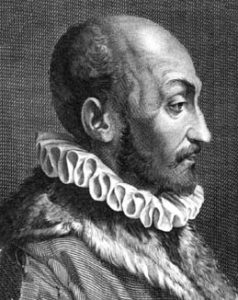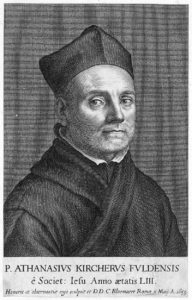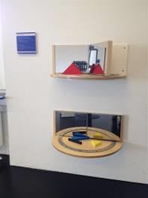Tasks
| |
Put one piece between the mirrors. How often do you see the piece? Does the number of images change when you move the mirror? |
| |
Using the stick, can you make an octagon? How about a square?
Using the stick, can you make a hexagon? How about a triangle?
Place a coin between the mirrors. Which images are flipped? |
| |
Which angles produce finitely many images? Given the angle can you predict how many images you will get? |
|
Maths
When an object is placed in the book, an image of the object is reflected in each mirror. The reflections are then reflected, making more images. Decreasing the angle between the mirrors increases the number of images.
If the angle is 90˚ we see the object four times, namely the original and three reflections. If the angle is 45˚ we see the object eight times. In this position we can place a stick to form an octagon. Or, if we place the stick at right-angles to one of the mirrors, we can make a square.
If we want to make N objects, the angle between the mirrors needs to be 360/N. So 180˚ makes 2 objects, 120˚ makes 3 objects, 90˚ makes 4 objects, and so on.
|
History
A long time ago scientists were already fascinated by the effect of two combined mirrors. In 1558, Giambattista della Porta described the relation between two hinged mirrors and explained the effect. In 1645, Athanasius Kircher described two hinged mirrors that could be open and closed like a book, how they can make regular polygon figures, and the relation between the angle and number of images. This early work lead to the science of optics.
|
People
 Giambattista della Porta 1535 – 1615 Giambattista della Porta 1535 – 1615
Giambattista della Porta was an Italian scholar and playwright. He is famous for his work in codes and secret messages, and claims to have invented the telescope. In 1558, he wrote a popular science book called Magia Naturalis (Natural Magic) where he described the effect of two hinged mirrors. |
 Athanasius Kircher 1602 – 1680 Athanasius Kircher 1602 – 1680
Athanasius Kircher was a German scholar who studied many subjects including medicine, geology and linguistics. He was one of the first to observe microbes and believed them to be the cause of the plague. Kircher was not a mathematician but did study ways to generate and count all combinations of objects. In 1645 Kircher wrote a booked called Ars Magna Lucis et umbrae (The Great Art of Light and Shade) where he described the relation between the angle of mirrors and the number of images. |
|
Applications
Mirrors and lenses are used in a variety of scientific instruments and everyday objects. These include telescopes, microscopes, cameras and fibre optic cables. These instruments magnify images or transmit light through a series of reflections.
A kaleidoscope uses two mirrors, at an angle, to create symmetrical patterns. Different kaleidoscopes vary in the angle used between the mirrors.
|
Maths at Home
Make a kaleidoscope at home with these instructions.
|



